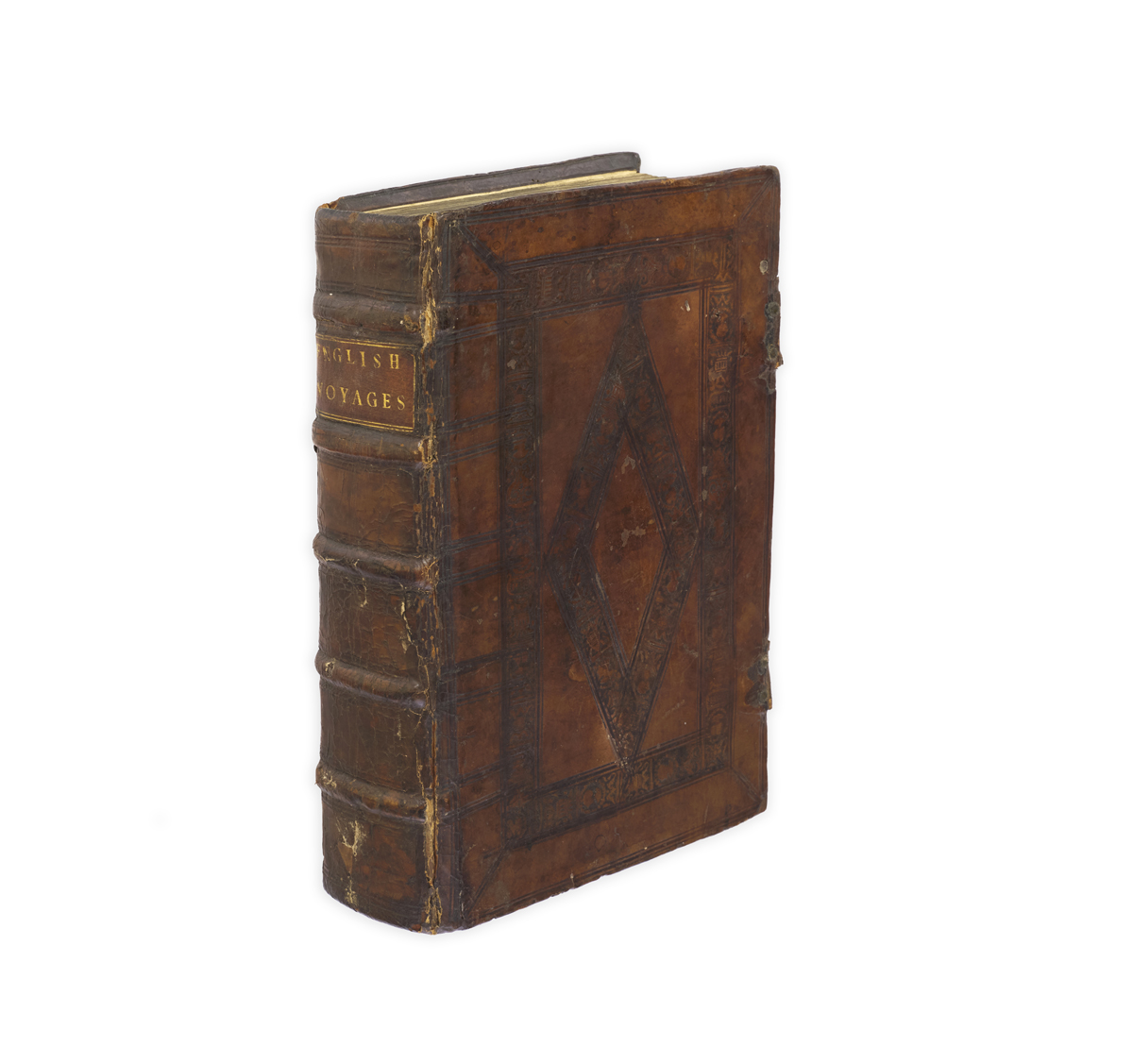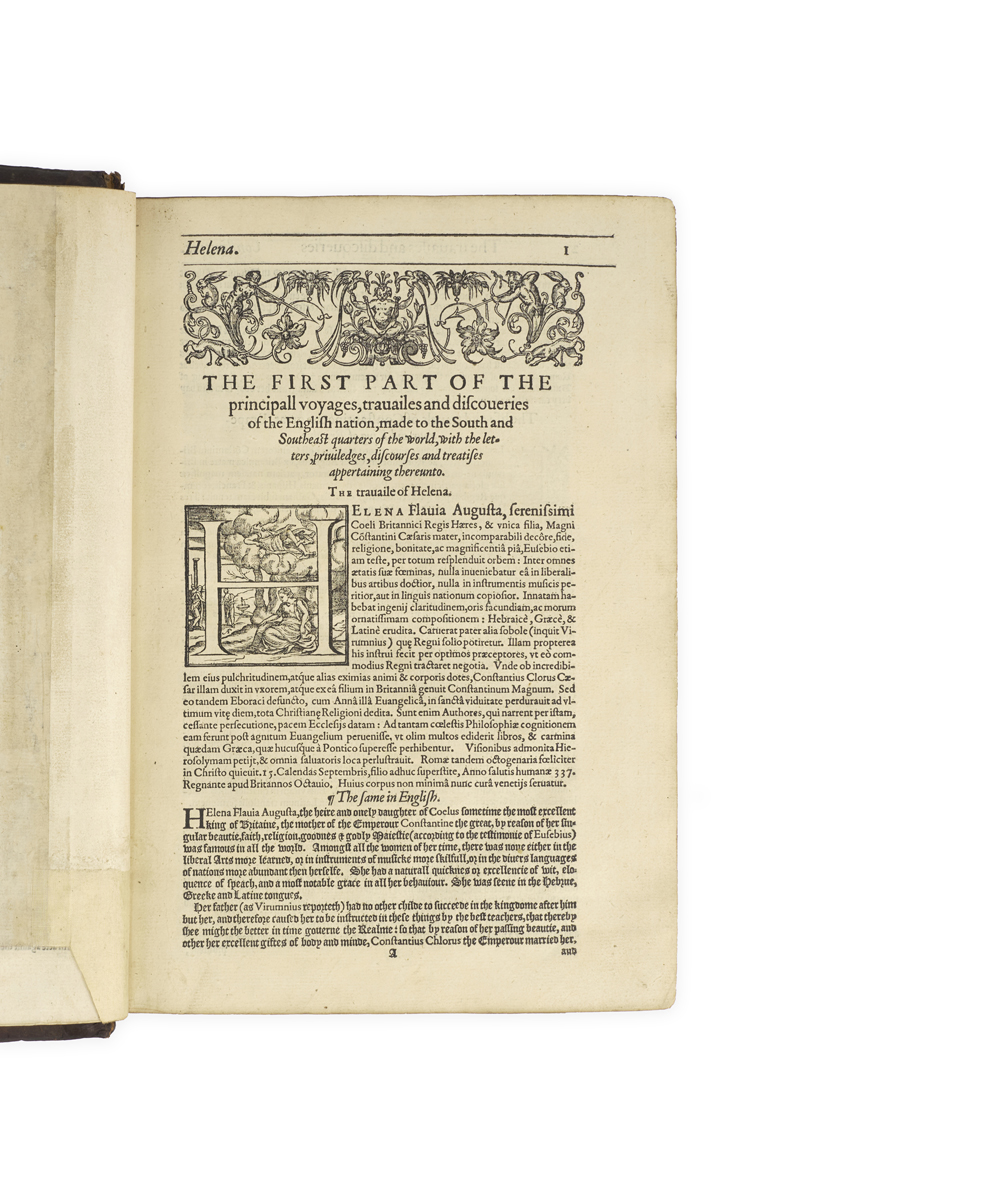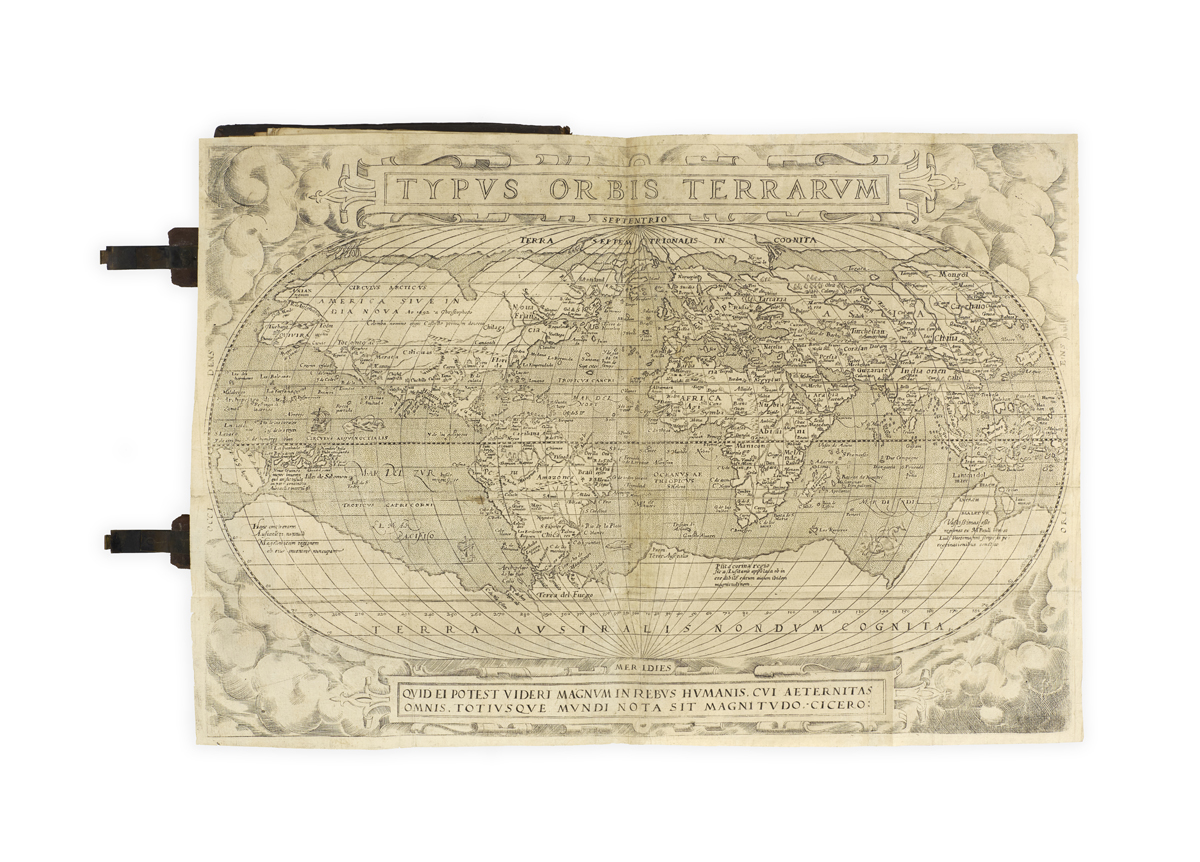



CONTEMPORARY CALF, WITH THE WORLD MAP
HAKLUYT, Richard.
The Principall Navigations, Voiages and Discoveries of the English Nation, made by Sea or over Land, to the most remote and farthest distant Quarters of the Earth at any Time within the Compasse of these 1500 Yeeres.
Imprinted at London by George Bishop and Ralph Newberie, Deputies to Christopher Barker … 1589.
Folio, pp. [16], 242, [2, blank], 243–505, [1], 506–643, [12], 644–825, [12], with the folding world map (333 x 485 mm, ‘Typus Orbis Terrarum’, after Ortelius (Shirley 167), often lacking, here washed and remounted), the medial blank X4 and the terminal final blank 4F4. and the six unpaginated ‘Drake leaves’ (not always present); Bowes leaves in the first state (headed ‘The Ambassage of Sir Hierome Bowes to the Emperour of Moscovie 1583’, paginated 491–505); short tear to foot of R1 neatly repaired, small rusthole in Ll2–3, else a fine, crisp copy recased in its original, strictly contemporary London binding of roll-tooled calf over wooden boards (heads in wreaths and a capstan, not in Oldham), clasps repaired using the original metalwork, spine dry and with some restoration, some wormholes to rear cover, new endpapers; crimson morocco pull-off box.

Added to your basket:
The Principall Navigations, Voiages and Discoveries of the English Nation, made by Sea or over Land, to the most remote and farthest distant Quarters of the Earth at any Time within the Compasse of these 1500 Yeeres.
First edition, a fine copy, with the world map, in a strictly contemporary London binding, of the first collection of English voyages.
‘Richard Hakluyt’s collection of voyages is one of the more famous works of Elizabethan history and literature, but it is generally known and read in the three-volume edition, The principal navigations, of 1598–1600 … To get the freshest flavour from Hakluyt it is necessary to go to The principall navigations (distinguished conveniently by the doubled l of the second word in the title) of 1589. The narratives are nearer to the events they describe, some of them being tumbled in while the book was in the press, and Hakluyt set them out … in a way which makes many of them more vivid and effective than after they had been sifted, scrubbed or pruned for the second edition …. The main bulk of the English voyages made in the early and middle parts of the Elizabethan period is already there, sometimes in versions of which this first edition is the only extant record. The first edition shows how Hakluyt went to work and it represents his original purposes in setting out a great, comprehensive collection on English achievements overseas’ (Burns).
The world map combines several of Ortelius’s maps, with the central oval taken from his third world map of 1587, and the cloud border from earlier plates. It was later re-used in the 1598 English translation of Linschoten’s Voyages.
The present copy, with its few and minor faults, is in our opinion one of the best likely to appear on the market. The text, which is fresh and clean, includes the six ‘Drake leaves’ following p. 643, giving the earliest printed narrative of Drake’s celebrated circumnavigation (1577–80), and has the ‘Bowes leaves’ in their first state (pp. 491–501). These bibliographical points are best explained by Quinn: ‘after the book was complete and printed off two events took place which were to alter the form of surviving copies. In the first place permission was received to print an account of Drake’s circumnavigation. Hakluyt had indeed begun to prepare such an account but withdrew it so as not to prejudice a collection of Drake’s voyages which was in preparation. Permission now came to insert it, not improbably from Drake himself. Accordingly Hakluyt, or one of his assistants, pared down the available materials … had them printed on the same paper and in the same type as the rest of the book, and sent them out with most of the copies sold. It would appear that some few copies were issued without the Drake leaves, and that then a certain number were issued with the Drake leaves and without any other changes [as in the present copy]. At that point a further alteration took place: the leaves containing Sir Jerome Bowes’s report of his Russian embassy in 1583–4 were cancelled’, possibly at the instigation of the Russia Company. ‘In any event, a more discreet and shorter version of Bowes’s narrative was prepared: “printed this second time, according to the true copie I received of a gentleman that went on the same voyage, for the correction of the errours in the former impression”, as Hakluyt says’. Quinn also notes that only about ‘one copy in three of the surviving examples contains the map’.
The current Hakluyt census (which does not record this copy), notes only six copies in contemporary calf in this, the most ideal state, with the world map, the Drake leaves, and the first state of the Bowes leaves: Yale (Taylor 188); YCBA (the Mellon copy); Newberry (Drake leaves supplied); Detroit Public Library; Philadelphia Library Company (Drake leaves probably supplied); and the Streeter copy (sale of 20 October 1970). The Streeter copy is the only comparable copy to have sold at auction this century ($380,000 in 2007).
Alden 589/31; Church 139–139A; Quinn, pp. 474–89; STC 12625.